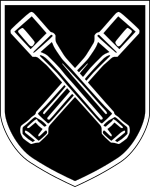36th Waffen Grenadier Division of the SS
|
36th Waffen Grenadier Division of the SS |
|
|---|---|
 Troop registration |
|
| active | February 19, 1945 to May 1945 |
| Country |
|
| Armed forces |
|
| Branch of service | Grenadiers |
| Type | division |
| structure | See outline |
| Strength | 6,000 men |
| commander | |
| Important commanders |
|
The 36th Waffen Grenadier Division of the SS was formed by order of Himmler on February 19, 1945 from the SS Storm Brigade Dirlewanger and some army units. Although Oskar Dirlewanger had been replaced as Storm Brigade Leader by Fritz Schmedes on February 16 because of an injury, this division was often given the addition of Dirlewanger .
History of the division
From the end of May 1940 under Oskar Dirlewanger in the Sachsenhausen concentration camp , poachers who had hunted with rifles from all over Germany were brought together to form the Oranienburg poachers' command. At the end of the training, 55 soldiers were transferred as " Sonderkommando Dirlewanger " to the Generalgouvernement in Lublin under the command of the Higher SS and Police Leader Odilo Globocnik . As of February 1942, the command, which had grown to almost 100 men, was transferred to Belarus to fight partisans, where it was assigned to Curt von Gottberg . From November 11, 1942, after being increased, it was called "SS-Sonderbataillon Dirlewanger", in 1943/1944 it became the "SS-Sonderregiment Dirlewanger". In July 1944, the regiment became the "SS Storm Brigade Dirlewanger".
On February 20, 1945, the brigade was ordered back to German territory, reinforced by army troops and converted into a division that was used against the Red Army .
Composition of the division
Most of the 6,000 or so soldiers in the division were members of the SS and the Wehrmacht; 250 were political concentration camp prisoners; The number of so-called anti - socials and common criminals who had also been assigned to the unit from concentration camps was even lower . The division was divided between the 9th and 4th Panzer Armies from the start . It was reinforced with 100 officer students from an SS Junker School , who were immediately employed as section and company commanders as well as superiors of 400 prisoners who had come from an SS prison. With the start of the last major Soviet offensive on April 16, 1945, the two armies were encircled and wiped out in the Halbe pocket, almost 100 kilometers south of Berlin. For April 25th, only 36 combat-capable soldiers of the 2nd regiment could be counted. 634 men returned from Soviet captivity, according to the documents of the tracing service of the German Red Cross .
At the latest from the end of 1944, when the brigade with 800 political prisoners was refreshed and first deployed in Slovakia to fight the Slovak national uprising and then fought against the Red Army around Budapest, poachers could no longer be spoken of as the core of the unit. But it had not become a unit of "anti-fascists in SS uniform" (H.-P. Klausch), especially since they had defected to the enemy in regimental strength in Hungary. According to a testimony of June 28, 1946, the brigade had already consisted for the most part of disciplinary members of the Wehrmacht.
Outline (February 20, 1945)
- Waffen Grenadier Regiment of the SS 72
- Waffen Grenadier Regiment of the SS 73
- SS Artillery Department 36
- SS Fusilier Company 36
- SS News Company 36
- SS Artillery Department 36
(Army troops)
- Pioneer Brigade 687
- Grenadier Regiment 1244
- Heavy tank destroyer detachment 681
- Panzer Department Stahnsdorf I
commander
- February 20 to April 1945: SS Brigade Leader and Major General of the Waffen SS and Police Fritz Schmedes
Individual evidence
- ↑ Ingrao (2006), p. 61.
- ↑ See Klausch (1993), p. 312.
- ↑ See Ingrao (2006), p. 63.
- ↑ See Ingrao (2006), p. 58.
literature
- Christian Ingrao: Les chasseurs noirs. La brigade Dirlewanger , Perrin, Paris 2006, ISBN 978-2-262-02424-6 .
- Hans-Peter Klausch: anti-fascists in SS uniform. Fate and resistance of the German political concentration camp prisoners, prison prisoners and Wehrmacht prisoners in the SS special formation Dirlewanger. Edition Temmen , Bremen 1993, ISBN 3-86108-201-2 .
- French L. MacLean: The Cruel Hunters. SS-Sonder-Kommando Dirlewanger, Hitler's Most Notorious Anti-Partisan Unit. Schiffer, Atglen 1998, ISBN 0-7643-0483-6 .
- Rolf Michaelis : The SS-Sonderkommando Dirlewanger. Use in Belarus 1941–1944. 2nd, revised edition, Michaelis-Verlag, Berlin 2006, ISBN 978-3-930849-38-3 .